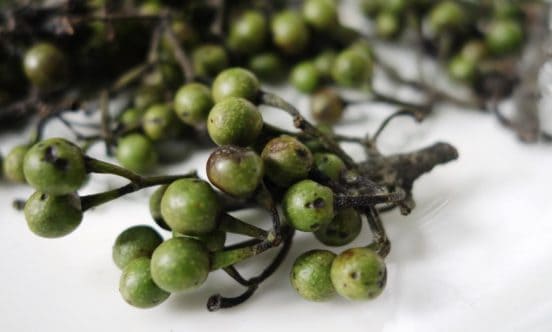I wish I could say I was out exploring wild mountains of the Chinese countryside, but it was just a linguistic observation explored online that led me to a “pepper” I had never before heard about:
Wondering about the different names/Chinese characters given to Sichuan pepper in Japan, where it is 山椒 / sanshou (mountain pepper), versus China, where it is 花椒 / huajiao (flower pepper), I just checked what the Chinese internet would tell me about 山椒.
The results suggested that I might be looking for 山胡椒 / shanhujiao, which would, going by current terminology, translate as mountain black pepper. Let’s just call it Chinese mountain pepper. It was obviously something different from anything I had seen before, though…

Turns out it is a species of Lindera, which is best known because the North American “spicebush” belongs to this genus. it contains about 100 species in North America and Asia, of which 38 species can be found in China.
This particular one used as a spice (and for wood carving and oil as well as medicinally) is apparently Lindera glauca. But, as so often happens with such spices, there is quite a bit of confusion.
By the looks of it, Lindera glauca is the one species addressed simply as shanhujiao whereas the other species would be labeled as other or more-specific kinds of shanhujiao.
The confusion isn’t helped, though, by the existence of other names for this species and spice, some of which overlap with the names for another spice that looks and is used very similarly, but is actually Litsea cubeba (which is another species of another genus, but also belongs to the Lauraceae, just as the Lindera).
Even the Flora of China has to concede that “The Chinese species of Lauraceae remain poorly known and difficult to identify” as “for a substantial number of species the fruits or flowers are not known.”
Perhaps the most interesting thing about it all, though, is not the botanical problem, Rather, it is that here is a spice that is basically unknown outside of China, which, at the same time, is another pungent spice (besides Sichuan pepper) from just those parts of China where the chilli, once it was introduced to China, quickly gained tremendous importance.
This is so peculiarly interesting an observation (to me, researching and writing on the chilli in China,) because it was likely this prior familiarity with pungent spices that made Chinese in these areas so readily adopt the chilli in their cooking.

Leave a Reply
You must be logged in to post a comment.